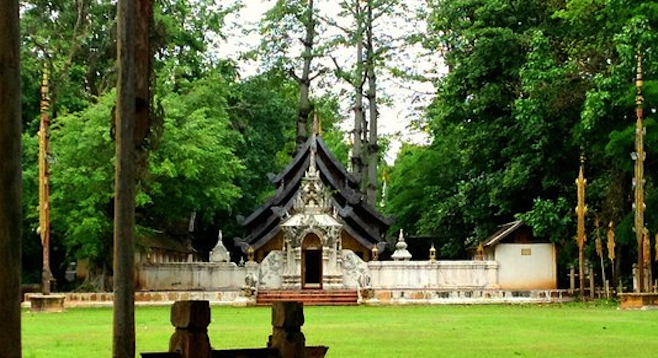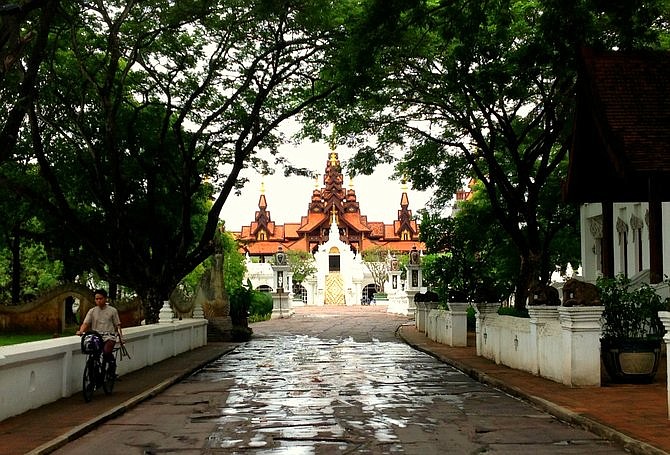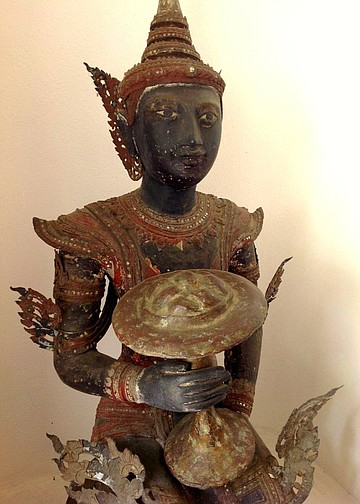 Facebook
Facebook
 X
X
 Instagram
Instagram
 TikTok
TikTok
 Youtube
Youtube

The strong smell of black coffee served in a plastic cup no bigger than a shot glass startled me from my deep slumber.
As one flight attendant pushed the cart forward, tightly squeezing it along the narrow neon-lit aisle while offering coffee to half-awake passengers, the early morning flight out from Bangkok had left some of us in a zombie-like state and my travel partner with bloodshot eyes.
A glimpse from my window unveiled the sun’s rays slowly peeking through the heavy clouds. Never had it been so gentle during our time in the “Land of Smiles.”

Just around the time my lunch tray was taken away, the plane began its descent into Chiang Mai International Airport. The quick one-hour flight deposited us in a landlocked region known as the “Rose of the North,” whose enchanting landscape is surrounded by lush forests and vast mountain ranges trailing down the Himalayan terrain (not to be confused with the Himalayas in Nepal) of northern Thailand.
Our journey to the 700-year-old and fifth-largest city in the Kingdom of Thailand began on a seven-horsepower-engine tuk-tuk ride.

Setting foot in the roughly 1.5-kilometer walled city girdled by moats, we were transported back to an era when traveling was limited to a grueling boat ride or perilous elephant trek. Exploring the interior of Chiang Mai’s remaining ancient capital, we found rich historical detail woven throughout its more than 30 temples with Lanna, Burmese and Sri Lankan architectural influences.
At the top of our list was the Wat Phrathat Doi Suthep, which houses the holy relic of the Lord Buddha and sits close to the top of Mount Suthep. The entire city can be seen from the mountainside.
The first temple in Chiang Mai and its foundations was believed to be Wat Chiang Man. Built in 1296, it's where two rare statues – the Crystal and Marble Buddhas – dwell.
Wat Suan Dok is another must-see. Situated a kilometer west, this former imperial garden is now the site of a famed Buddhist university where both locals and intrepid tourists pay homage to a 500-year-old bronze Buddha, one of Thailand’s largest.
A 15-minute drive from the old town is Baan Chang, a sanctuary for elephants where tourists are encouraged to engage in taking care of the wild creatures. One extraordinary thing to marvel at is the bond that ties the mahouts (elephant trainer) and the gentle beasts.
As night fell, we found ourselves getting lost in the excitement of the vibrant night market.
Then it was time to go home. Phriya, our tuk-tuk driver, raised his hand, beckoning toward us as if saying, "Come along, come, come."
Everything seemed like it was happening in double time; I imagined our trip was about to start only to realize it was almost over. Truly, a quick visit to the Rose of the North leaves you smitten by its charm.
As it is, my enduring memory was the old lady with her primitive tok sen massage, when she hit my pressure points with the utmost precision and with a wooden gavel to boot. Then there were the temples, the elephant rides, the drives along sloping roads with rich paddy fields as a backdrop and the occasional halts, curbside, just to grab some cold bottles of Singha beer as all three of us raised our glasses and yelled "Chai-yo!" ("Cheers!")
I could only pause for awhile and let the moment take my breath away – and then want of nothing else.


The strong smell of black coffee served in a plastic cup no bigger than a shot glass startled me from my deep slumber.
As one flight attendant pushed the cart forward, tightly squeezing it along the narrow neon-lit aisle while offering coffee to half-awake passengers, the early morning flight out from Bangkok had left some of us in a zombie-like state and my travel partner with bloodshot eyes.
A glimpse from my window unveiled the sun’s rays slowly peeking through the heavy clouds. Never had it been so gentle during our time in the “Land of Smiles.”

Just around the time my lunch tray was taken away, the plane began its descent into Chiang Mai International Airport. The quick one-hour flight deposited us in a landlocked region known as the “Rose of the North,” whose enchanting landscape is surrounded by lush forests and vast mountain ranges trailing down the Himalayan terrain (not to be confused with the Himalayas in Nepal) of northern Thailand.
Our journey to the 700-year-old and fifth-largest city in the Kingdom of Thailand began on a seven-horsepower-engine tuk-tuk ride.

Setting foot in the roughly 1.5-kilometer walled city girdled by moats, we were transported back to an era when traveling was limited to a grueling boat ride or perilous elephant trek. Exploring the interior of Chiang Mai’s remaining ancient capital, we found rich historical detail woven throughout its more than 30 temples with Lanna, Burmese and Sri Lankan architectural influences.
At the top of our list was the Wat Phrathat Doi Suthep, which houses the holy relic of the Lord Buddha and sits close to the top of Mount Suthep. The entire city can be seen from the mountainside.
The first temple in Chiang Mai and its foundations was believed to be Wat Chiang Man. Built in 1296, it's where two rare statues – the Crystal and Marble Buddhas – dwell.
Wat Suan Dok is another must-see. Situated a kilometer west, this former imperial garden is now the site of a famed Buddhist university where both locals and intrepid tourists pay homage to a 500-year-old bronze Buddha, one of Thailand’s largest.
A 15-minute drive from the old town is Baan Chang, a sanctuary for elephants where tourists are encouraged to engage in taking care of the wild creatures. One extraordinary thing to marvel at is the bond that ties the mahouts (elephant trainer) and the gentle beasts.
As night fell, we found ourselves getting lost in the excitement of the vibrant night market.
Then it was time to go home. Phriya, our tuk-tuk driver, raised his hand, beckoning toward us as if saying, "Come along, come, come."
Everything seemed like it was happening in double time; I imagined our trip was about to start only to realize it was almost over. Truly, a quick visit to the Rose of the North leaves you smitten by its charm.
As it is, my enduring memory was the old lady with her primitive tok sen massage, when she hit my pressure points with the utmost precision and with a wooden gavel to boot. Then there were the temples, the elephant rides, the drives along sloping roads with rich paddy fields as a backdrop and the occasional halts, curbside, just to grab some cold bottles of Singha beer as all three of us raised our glasses and yelled "Chai-yo!" ("Cheers!")
I could only pause for awhile and let the moment take my breath away – and then want of nothing else.
Comments